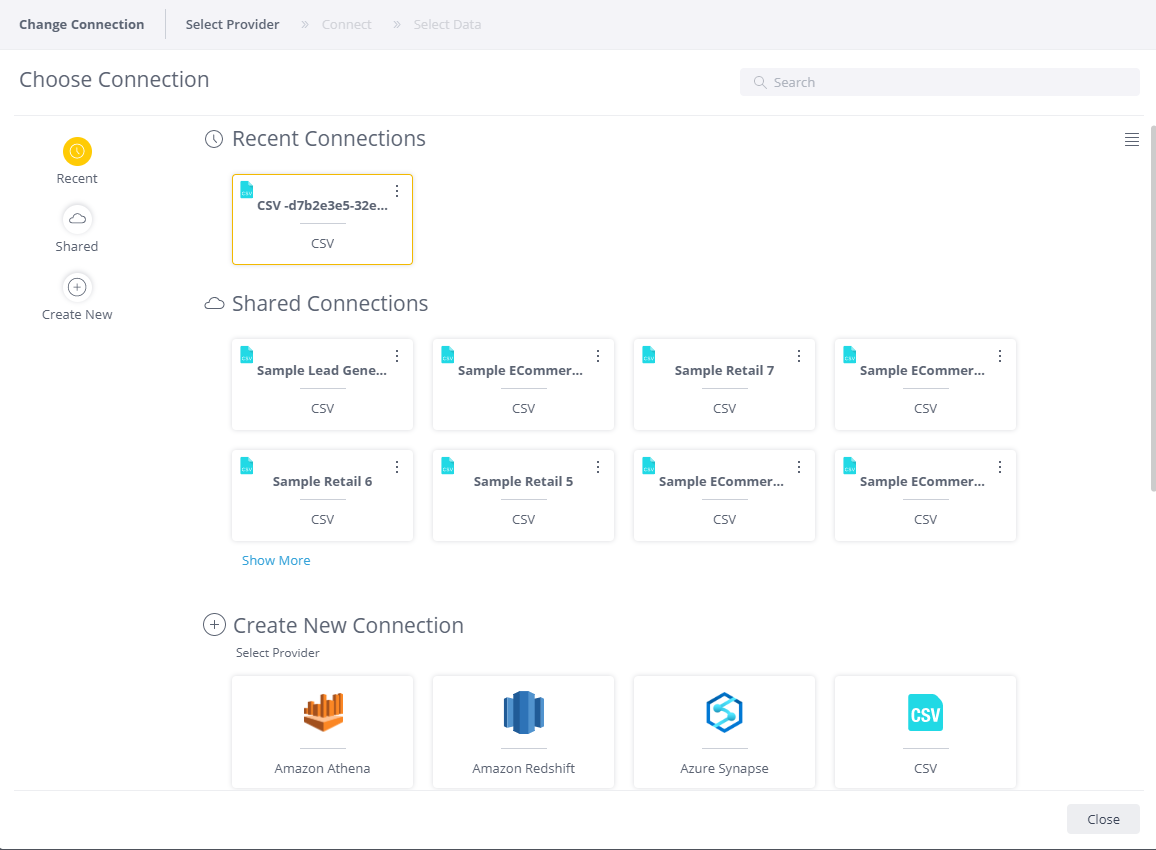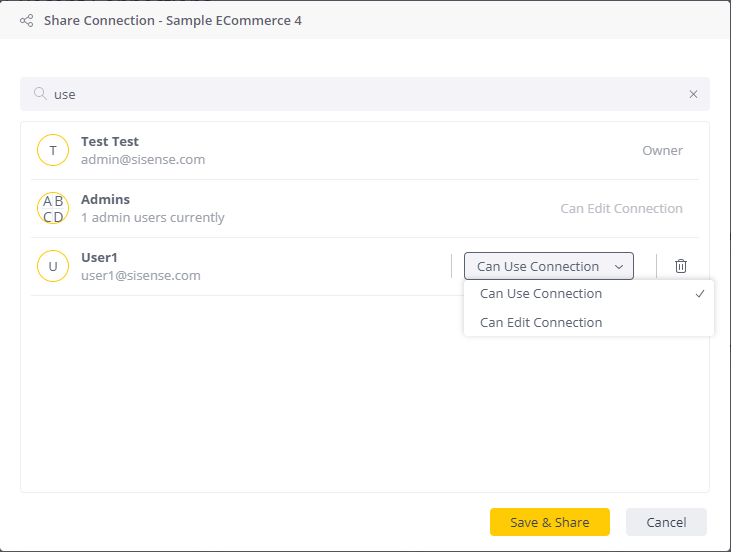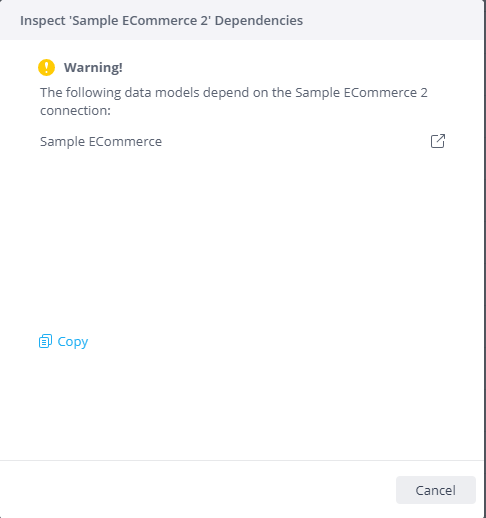Connection Management for Data Sources - BETA
Note:
This feature is currently in Beta. As such, it should be tested in a non-production environment, and used at your own discretion.
For Sisense to retrieve data from a data source, you need to create a connection between Sisense and the data source.
Please note the following terms:
-
Connector - A connector has the information required to connect to a particular type of data source. This enables connectivity between the data analytics tool and the data source. Multiple connections can be based on each connector.
-
Connection - A connection is based on a connector, together with the information required to connect to a specific data source instance. The instance information required is the data source's:
-
URL (connection string)
- Credentials
Each connection is tied to a specific data source, user, and table.
-
About Connection Management
Connection Management is a repository that holds all connections, each with its own connection ID. These connections can be shared with individual users or groups for connections to Live models, ElastiCubes, or B2D (cloud data warehouse).
Changes to connections in Connection Management is at the connection (global) level, affecting all tables that use that connection in all models that include those tables.
Changing connections in the data model via a table's option menu, changes the connection used for that table only, by selecting a different connection with a different connection ID.
Connection Management can be activated in Admin > Feature Management > Management.
Note:
-
When Connection Management is enabled manually for the first time, it runs a process that migrates all the connections in your system into the Connection Management system. Migration of an existing environment with many connections can take up to 10 minutes.
-
If turned off, a reverse migration will be triggered for the newly created/adjusted connection while it was on. The same waiting time is required for this (up to 10 minutes).
Connection Management also addresses some security concerns due to current data model sharing.
Example:
-
One person creates a data model and shares it with another person.
-
A person who creates a data model in one environment can share that data model with another environment.
Sharing that occurs outside Sisense, for example, by exporting a data model and then importing that data model in another environment or by another user, poses a potential security risk.
-
The exported data model includes the connection credentials, leaving a copy of the details outside Sisense.
-
If shared across environments, the person importing the data model into another environment may need to request the password from the original data model owner in order to create a new connection for the other environment. This may result in the password details being exchanged in an unencrypted format.
To address these security issues and improve connection sharing efficiency, connections are now shared via Connection Management, once Connection Management is initially enabled.
Sharing connections via Connection Management means that no copies of connection credentials reside outside Sisense, and no passwords need to be manually exchanged in an unsecured way.
Creating New Connections
When Connection management is enabled, from the Data tab, you create a new connection by clicking the  icon.
icon.
In the Choose Connection screen, Connection Management allows you to:
-
Use a recently used connection
-
Use a shared connection
-
Create a new connection from one of the connectors available to you

If there are more than eight recent or shared connections and the one you want is not visible, you can click Show More to see the other connections that you recently used or connections that are shared with you and select the one you want.
Alternatively, you can click the icon in the top right corner to display the existing and shared connections as a list.
Example:

You can:
-
Select one of these existing or shared connections
-
Click Create New on the left of the list pane
Alternatively, scroll down the page to the Create New Connection section and click the icon of the connection type you want to create, and populate the field values to create the new connection.
Sharing Connections
New connections can be shared during the connection creation process by clicking Share.
Existing connections can be shared from the Choose Connection page. To reach the Choose Connection page:
-
From the data model diagram, or list of tables in the data model, from the table's 3-dots menu, select Connection Settings > Switch Connection. The Choose Connection window appears.

-
From the 3-dots menu of an existing connection, listed in either the Recent Connections or Shared Connections list, select Share.

The Share Connection window appears.

To share the new or existing connection:
-
Start typing the name of the user or group you want to share the connection with. When the correct name appears in the menu below the search bar, select it.

The user or group name will appear in the list of users and groups allowed access to the connection.

-
Use the drop-down menu to determine the user or group's access permissions - either only the right to use the connection, or the right to use and edit the connection. (If you added the wrong user or group by mistake, click the delete icon (
 ) to remove the user or group from the list.)
) to remove the user or group from the list.) -
Click Save & Share to grant the user or group the permission to share the connection (at the access level you set).
Editing a Connection
To edit a connection, from the data model page, click  to open the Choose Connection screen. Click the 3-dots menu of the connection you want to edit and, from the menu, select Edit. The Connect screen appears, allowing you to change the connection settings.
to open the Choose Connection screen. Click the 3-dots menu of the connection you want to edit and, from the menu, select Edit. The Connect screen appears, allowing you to change the connection settings.
Important:
-
Be aware that editing a connection here applies the changes to all tables in all models that use this connection.
-
If you only want to edit the connection of a particular table in a particular model, use Switch Connection from the Connection Settings menu instead.
Checking a Connections Dependencies
To see which models use a particular connector, from the 3-dots menu of a connection, select Dependencies. The list of data models that depend on the connection is displayed.
Example:

You can click Copy to copy the list of dependencies to paste externally into an editor.
Example:
You can use this list to check that you have addressed all data models that use this connection and assigned them a different connection before deleting the connection.
To exit this page, click Cancel.
Deleting a Connection
Important:
Deleting a connection deletes it from all data models.
To delete a connection:
-
From the data model page, click
 to open the Choose Connection screen.
to open the Choose Connection screen. -
Click the 3-dots menu of the connection you want to delete and, from the menu, select Delete. The screen displays the list of available connections.
-
Select the connection that will replace the connection you are about to delete, and then click Delete Connection.
Example:

Limitations
Sharing a connection in the Notebooks tab is not supported.
Training Course
Click here for the Connection Management training course.